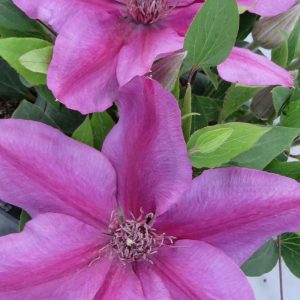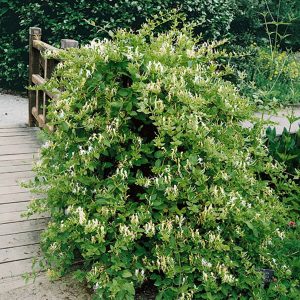Description
Rosmarinus officinalis ‘Prostratus’ commonly known as Trailing Rosemary is a woody, perennial herb that is commonly used in cooking and as a garnish. It is known for its fragrant, needle-like leaves and its small, blue flowers that bloom in spring and summer. The leaves can be used fresh or dried to add flavor and aroma to a variety of dishes, such as soups, stews, and roasted meats. This variety is known for its trailing habit, which makes it perfect for hanging baskets, cascading over walls, or as a ground cover.
Key Facts
- Common Name(s):Trailing Rosemary
- Hardiness:Half hardy and would benefit from protection through Winter.
- How big will I get? Rosmarinus officinalis ‘Prostratus’ can grow to a height of 0.5m and a spread of 1.5m.
- Did You Know That:In the Mediterranean rosemary is associated with remembrance, and is commonly used in weddings, funerals, and other ceremonies?
Plant Calendar
A rough guide to how this plant will change through the year.
| Jan | Feb | Mar | Apr | May | June | July | Aug | Sept | Oct | Nov | Dec | |
| Flowering Time |  |
 |
 |
 |
||||||||
| Foliage Colour |  |
 |
 |
 |
 |
 |
 |
 |
 |
 |
 |
 |
| J | F | M | A | M | J | J | A | S | O | N | D |
 |
 |
 |
 |
||||||||
 |
 |
 |
 |
 |
 |
 |
 |
 |
 |
 |
 |
Care Guide

Soil Requirements
Rosmarinus officinalis ‘Prostratus’ is a versatile plant and can cope with wet or drier soils, but prefers there to be decent drainage. This plant can grow in soil with a wide range of pH levels, it is not picky about the pH level of the soil.

Best Position
Rosmarinus officinalis ‘Prostratus’ prefers a sheltered position and requires full sun to thrive, this consists of more than six hours of direct sunshine per day.

Maintenance
Rosmarinus officinalis ‘Prostratus’ is fairly low maintenance and doesn’t require any pruning.

Pest, Diseases and Wildlife
Rosmarinus officinalis ‘Prostratus’ can have problems with scale insects , and it tends not to have problems with diseases. It is also known to attract bees. It is not considered to be toxic.
![Rosmarinus officinalis [Trailing Rosemary]](https://leafwise.co.uk/wp-content/uploads/2022/10/Rosmarinus-officinalis-Trailing-Rosemary.jpg)




